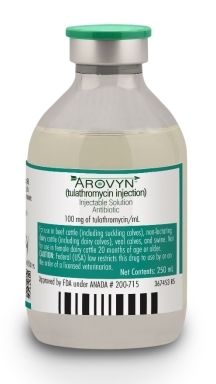New antibiotic for cattle and swine is available
Tulathromycin injection is an option for bovine respiratory disease, and other conditions
Credit: Merck Animal Health

Tulathromycin injection (Arovyn; Merck Animal Health) is now available to veterinarians. The prescription antibiotic is indicated for bovine respiratory disease (BRD) as well as foot rot and pinkeye, according to Merck.1
Merck Animal Health announced FDA approval of the drug in March 2022 for cattle and swine.2 Tulathromycin injection is available in 50-, 100-, 250- and 500-mL vials.1
In beef and nonlactating dairy cattle, tulathromycin injection is indicated for the treatment of BRD and control of respiratory disease in animals at high risk of developing BRD associated with Mannheimia haemolytica, Pasteurella multocida, Histophilus somni and Mycoplasma bovis. It also is approved for treatment of infectious bovine keratoconjunctivitis—pinkeye— associated with Moraxella bovis, and treatment of foot rot associated with Fusobacterium necrophorum and Porphyromonas levii. In suckling calves, dairy calves, and veal calves, tulathromycin injection is indicated for treatment of BRD associated with M. haemolytica, P. multocida, H. somni and M. bovis.1,2
BRD is a condition known to be one of the costliest for beef cattle in North America and predisposes these animals to pneumonia. Risk factors for BRD include commingling, and purchase from sale barns. Calves at lighter weight and those that have been transported are at higher risk for BRD.3
“[Tulathromycin injection] offers veterinarians and producers a new, cost-effective option for tulathromycin,” said David Sjeklocha, DVM, technical services manager, Merck Animal Health, in an organizational press release.1 “On-label to administer on arrival with high-risk cattle, [tulathromycin injection] can be used to treat BRD, foot rot and pinkeye—all of which are common and costly diseases.”
Tulathromycin injection should not be used in female dairy cattle aged 20 months or older. It has a preslaughter withdrawal time of 18 days in cattle and 5 days in swine, according to Merck Animal Health.1,2
References
- Merck Animal Health announces Arovyn is available. News release. May 24, 2022. Accessed May 31, 2022. https://www.merck-animal-health-usa.com/newsroom/merck-animal-health-announces-arovyn-is-available
- Merck Animal Health receives FDA approval of Arovyn. News release. March 3, 2022. Accessed May 31, 2022. https://www.merck-animal-health-usa.com/newsroom/merck-animal-health-receives-fda-approval-of-arovyn
- Taylor JD, Fulton RW, Lehenbauer TW, Step DL, Confer AW. The epidemiology of bovine respiratory disease: what is evidene for predisposing factors? Can Vet J. 2010;51(10):1095-1102. Accessed May 31, 2022. https://www.ncbi.nlm.nih.gov/pmc/articles/PMC2942046/#b1-cvj_10_1095